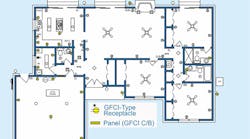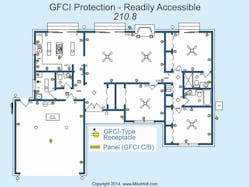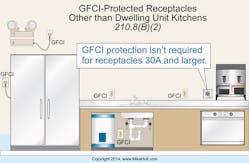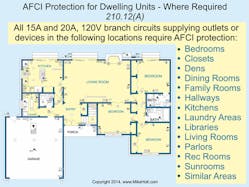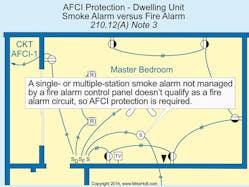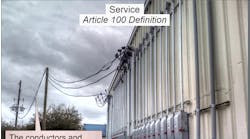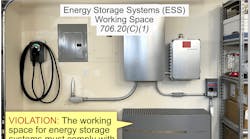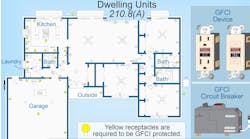Two different technologies protect against two different types of hazard. Ground fault circuit interrupter (GFCI) devices protect people from shock by opening a circuit at a low threshold of leakage current (typically 6mA). Arc fault circuit interrupter (AFCI) devices protect buildings and occupants by opening a circuit upon detection of an arc fault. The threshold current for an AFCI is too high to protect individuals against shock. Both types of devices must be installed in readily accessible locations.
GFCIs
A GFCI device must be installed (Fig. 1) in the places named in Sec. 210.8(A) through (D). These include both dwelling units and other than dwelling units.
GFCI protection at dwelling units is required for all 15A and 20A, 125V receptacles installed in:
1) Bathroom areas.
2) Garages and accessory buildings. This includes grade-level portions of accessory buildings used for storage or work areas of a dwelling unit. If you install a 15A or 20A, 125V receptacle in an accessory building, it must be GFCI protected.
3) Outdoors. This includes all receptacles outside a dwelling unit. Each unit of a multifamily dwelling with individual entrances at grade level must have at least one GFCI-protected receptacle accessible from grade level and not more than 6½ ft above grade [210.52(E)(2)]. Attached balconies, decks, and porches accessible from inside the unit must each have at least one GFCI-protected receptacle [210.52(E)(3)].
4) Crawl spaces. The NEC requires a receptacle in a crawl space only if it contains heating, air-conditioning, and refrigeration equipment [210.63].
5) Unfinished basements. These are the unfinished portion(s) not intended as a habitable room and limited to storage and work areas. Excluded are receptacles supplying only permanently installed fire alarm or burglar alarm systems [760.41(B) and 760.121(B)].
6) Kitchen countertop surfaces
7) Sinks. This includes only receptacles within an arc measurement of 6 ft from the outside edge of a sink.
8) Boathouses. If you install a 15A or 20A, 125V receptacle in a boathouse, it must be GFCI protected.
9) Bathtubs or shower stalls. This includes only receptacles within 6 ft of the outside edge of a bathtub or shower stall.
10) Laundry areas.
GFCI protection at other than dwelling units (i.e., commercial/industrial locations) is required for all 15A and 20A, 125V receptacles installed in:
1) Bathrooms. If you install a 15A or 20A, 125V receptacle in a commercial or industrial bathroom, it must be GFCI protected.
2) Kitchens. This includes even those receptacles that don’t supply the countertop surface (but not those rated other than 15A and 20A, 125V) (Fig. 2).
3) Rooftops.
4) Outdoors.
However, there is an exception for rooftops and outdoor locations. Exception No. 2 to (3) and (4) above states: GFCI protection isn’t required for a receptacle supplied by a branch circuit dedicated to fixed electric snow-melting or deicing or pipeline and vessel heating equipment, if the receptacle isn’t readily accessible and the equipment or receptacle has ground fault protection of equipment (GFPE) [426.28 and 427.22].
5) Sinks. This includes only receptacles installed within 6 ft of the outside edge of a sink. Excluded are receptacles in patient bed locations of general care or critical care areas of health care facilities. Also excluded are, in industrial laboratories, receptacles used to supply equipment where removal of power would introduce a greater hazard.
6) Indoor wet locations.
7) Locker rooms, if they have associated showering facilities.
8) Garages. This includes service bays and similar areas, unless in showrooms or exhibition halls.
Going back to dwelling unit locations for a moment, there are two additional GFCI requirements to note. As noted in Sec. 210.8(C), GFCI protection is required for 120V and 240V outlets for boat hoists installed at dwelling unit locations. And as called out specifically in Sec. 210.8(D), GFCI protection shall be provided for outlets that supply both hardwired and cord- and plug-connected dishwashers installed in dwelling unit locations.
AFCIs
So, what does the Code have to say about AFCI requirements? AFCI protection must be provided per Sec. 210.12(A), (B) and (C).
All 15A or 20A, 120V branch circuits in dwelling units supplying outlets or devices in kitchens, family rooms, dining rooms, living rooms, parlors, libraries, dens, bedrooms, sunrooms, recreation rooms, closets, hallways, laundry areas, or similar places (Fig. 3) must be protected by one of the following (all listed):
1) Combination-type AFCI, installed to protect the entire branch circuit.
2) Branch/feeder-type AFCI at the origin of the branch circuit, plus a listed outlet branch circuit AFCI installed at the first outlet box of the branch circuit. The outlet box must be marked to indicate that it’s the first outlet box of the circuit.
3) Supplemental arc protection circuit breaker installed at the origin of the branch circuit, plus a listed outlet branch circuit-type AFCI installed at the first outlet box on the branch circuit. When using this option:
a) The branch circuit wiring must be continuous from the branch circuit overcurrent protection device (OCPD) to the AFCI device.
b) The maximum length of the branch circuit to the AFCI is 50 ft for 14 AWG conductors or 70 ft for 12 AWG conductors.
c) The first outlet box in the circuit must be marked to indicate that it’s the first outlet box of the circuit.
4) A regular fuse or circuit breaker, plus a listed outlet branch circuit-type AFCI installed at the first outlet of the branch circuit. When using this option, the same conditions apply as for (3) above, but also the combination of the branch circuit OCPD and the AFCI must be listed and identified as meeting the requirements for a “System Combination” type AFCI.
5) You can use a listed outlet branch circuit-type AFCI at the first outlet, if the wiring between the OCPD and the AFCI contains all metal boxes and is installed using any (or a combination) of the following: RMC, IMC, EMT, Type MC, Type AC cables meeting the requirements of Sec. 250.118, metal wireways, or metal auxiliary gutters.
6) You can use a listed outlet branch circuit-type AFCI at the first outlet if the wiring between the OCPD and the AFCI is in a raceway with 2 in. of concrete encasement.
In addition, all 120V, single-phase, 15A and 20A branch circuits supplying outlets in dormitory unit bedrooms, living rooms, hallways, closets, and similar rooms must be AFCI protected.
What about the combo AFCI? The combination AFCI is a circuit breaker that protects downstream branch circuit wiring plus cord sets and power supply cords; an outlet branch circuit AFCI (receptacle) is installed as the first outlet in a branch circuit to protect downstream branch circuit wiring, cord sets, and power supply cords.
Where branch circuit wiring is modified, replaced, or extended in any of the areas specified in Sec. 210.12(A), the branch circuit must be protected by a listed [210.12(B)]:
1) Combination AFCI located at the origin of the branch circuit; or
2) Outlet branch circuit AFCI located at the first receptacle of the existing branch circuit.
Exception: AFCI protection isn’t required for extensions less than 6 ft long if there are no outlets or devices added.
Are there any locations where you can omit the installation of an AFCI? The 120V circuit limitation means AFCI protection isn’t required for equipment rated 230V, such as a baseboard heater or room air conditioner. You can also omit AFCI protection for an individual branch circuit to a fire alarm system in accordance with Sections 760.41(B) and 760.121(B), if the circuit conductors are installed in metal wireways, metal auxiliary gutters, RMC, IMC, EMT, or steel sheath Type AC or MC cable that qualifies as an equipment grounding conductor in accordance with Sec. 250.118, with metal outlet and junction boxes.
Smoke alarms connected to a 15A or 20A circuit in a dwelling unit must be AFCI protected if the smoke alarm is in one of the areas specified in Sec. 210.12(A). The exemption from AFCI protection for the “fire alarm circuit” contained in Sections 760.41(B) and 760.121(B) doesn’t apply to the single- or multiple-station smoke alarm circuit typically installed in dwelling unit bedroom areas. This is because a smoke alarm circuit isn’t a fire alarm circuit as defined in NFPA 72, “National Fire Alarm Code.” Unlike single- or multiple-station smoke alarms, fire alarm systems are managed by a fire alarm control panel (Fig. 4).
Exercise judgment
It’s important to remember that, despite how detailed 210.8 and 210.12 are, the people serving on the Code Making Panel for Art. 210 can’t think of every possible scenario. In applications where GFCI or AFCI isn’t required, this does not mean they are prohibited. It means they are optional.
Optional means you should exercise your judgment. Think about the application and whether there’s a reasonable chance of a hazard that an optional GFCI and/or AFCI would protect against, given the intended use of the occupancy. Yes, these do cost a little more, but the owner may gladly pay for the added protection if you explain your reasoning and the possible consequences of going without it.
Holt is the owner of Mike Holt Enterprises, Inc. in Leesburg, Fla. He can be reached at www.mikeholt.com.
